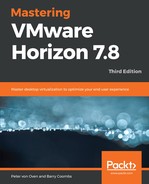To set up the desktop pool using the Horizon View Administrator, perform the following steps:
- From a workstation, open a browser and enter the address details of the View Connection Server. In the example lab, the address of the Connection Server is https://hzn7-cs1.pvolab.com/admin. Don't forget the /admin at the end; otherwise, you will end up on the Horizon Client page.
- You will now see the View Administrator login screen, as shown in the following screenshot:

- Log in using the administrator account that was set up for the View Administrator. You will now see the Horizon View Administrator Dashboard screen, as shown in the following screenshot:

- From the Horizon View Administrator, click to expand the Catalog option (1), and then click on Desktop Pools (2). Then from the Desktop Pools pane that is now displayed, click the Add... button (3).
- You will now see the Add Desktop Pool screen, starting with the Type section where we select the type of desktop pool you want to create:

- Click the radio button for Automated Desktop Pool (4). When selecting the various types of desktop pools that are available, the description on the right-hand side will change, reminding you of the differences between the pool types, as well as the features that are supported within each desktop pool.
- Now click the Next > button to continue.
- You will now see the User Assignment screen, as shown in the following screenshot:

- Click the radio button for Dedicated (5). The Enable automatic assignment option (6) will already be selected by default. This means the desktops will be assigned to the users on a first come, first served, as they log in. If, for some reason, you need to ensure a user is assigned a specific desktop, then you will need to uncheck this box, and manually assign them a virtual desktop machine.
- Click the Next> button to continue the configuration. You will now configure how the virtual desktop machines will be built, using the vCenter Server linked with this Connection Server, as shown in the following screenshot:

On this configuration screen, you have the option to build either Instant clones, View Composer linked clones, or Full virtual machines.
- For this first desktop pool, we are going to use Linked Clones, so click the radio button for View Composer linked clones (7).
- Next, you need to select the relevant vCenter Server from the list. In the example lab, the vCenter 192.168.1.178 is shown, along with the vCenter user account we set up for the View (8).
- Click the Next> button to continue the configuration. The next configuration screen is for the Desktop Pool Identification, as shown in the following screenshot:

- In the ID box (9), type in an ID for this desktop pool. In the example lab, we have entered the ID of Win7-dedicated-lc.
You can only use the characters a-z, A-Z, 0-9, -, and _ in the pool ID.
- In the Display name box (10), type in a name for this pool. Bear in mind that the display name is what is displayed to the end users, so make sure you give it a non-technical name that the users will understand.
- Finally, in the Description box (13), type in a detailed description that describes the desktop pool and what it is used for.
- Click the Next> button to continue the configuration. You will now see the Desktop Pool Settings configuration screen, as shown in the following screenshot:

This configuration page is where we start to configure the settings that will define the way the virtual desktop machines behave within the desktop pool. It provides configuration options for before users connect, while they are using their virtual desktop machine, and finally, once they disconnect from it.
There a number of options to configure on this screen so we are going to break them down into individual sections.
